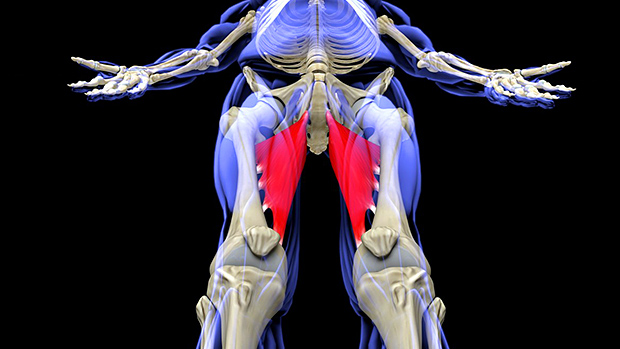I.L.S. – Imaginary Lat Syndrome
Enter any commercial gym and you'll see dozens of young men suffering from this condition, walking with arms outstretched as though returning from a two-for-one sale on invisible watermelons.
To more seasoned lifters, it's painfully obvious why these skinny wannabe muscle heads walk this way. They want to look big, broad, and intimidating, yet their go-to "program" of bench presses, biceps curls, and mid-set texting has left them looking like, well, dorks.
So they improvise and just adopt the standard gym peacock walk, hoping it will conceal their obvious lack of upper body mass. They're not fooling anybody.
Getting the back growing is key to achieving an imposing physique that gets noticed. The back is a huge, complex muscle group, which is why it looks so damn impressive when fully developed.
Building a thick back requires a variety of exercises and nut-busting intensity, but while many trainees implement advanced techniques for pressing exercises like partial reps, holds, negatives, clusters, and rest/pause reps, the back get's the missionary treatment of straight sets of rows, pulldowns, and deadlifts.
That won't get people confusing you with Matt Kroc anytime soon.
To that end, here are a few simple principles that will optimize the way a skinny guy should train his back for size.
1 – The Back Musculature is Composed Largely of Type 1 Muscle Fibers.

This is important. Knowing that the slow twitch (or Type 1) muscle fibers are littered throughout the back affects what rep range will make it respond best. The postural muscles, like your rhomboids, mid traps, supra and infraspinatus, and teres, must constantly contract to keep you standing straight and with decent posture.
Doing a standard 5 x 5 with seated rows or weighted pull-ups may lead to some back hypertrophy, but you'd be better off going for around 12 reps, and in some cases, even more. More on that later.
"What about deadlifts? That's an exercise often performed for 5 reps. Isn't that effective?"
Sure it is. Remember, deadlifts train much more than just the back, including the hamstrings and glutes that are chock full of high threshold motor units. Either way, during a deadlift, the rhomboids and postural muscles are holding a constant isometric to keep the upper back tight.
Even if the set were five reps, that's still a good 20 seconds of constant isometric tension being applied by the postural muscles, so you're ready for business. In other words, load up a heavy bar and pick it up!
2 – Using the Stretch Shortening Cycle is Not Always the Best Lifting Method.
In the bench press, squat, shoulder press, and other pushing movements, the stretch shortening cycle, or stretch reflex, is often applied for several reasons:
- To perform more reps for speed.
- To increase the weight lifted.
- To decrease neurological exhaustion.
According to Principle #1, the SSC doesn't apply as freely to pulling muscles. This isn't necessarily a bad thing. Time under tension is your friend, and it can be a welcome addition to your back training.
Dead-Stop Deadlift
No other lift in the world will give you the much needed lower and mid-back thickness as quickly as heavy deadlifts. Adding dead-stops means letting the bar settle on the ground for a full second between reps. This allows you to reset your low back, and the reps become like single-rep clusters.
Dead-Stop Pull-Up
If you can do 12 standard pull ups, chances are you'll only get about 2/3 of that number when you begin adding a dead-stop between each rep. Many lifters have the tendency, even when using their stretch reflex, to stop just short of full arm extension during pull-ups (see the first two videos below – the difference is subtle, but significant). Ditch the weighted belt for a couple weeks and try these. (Third video is the dead-stop pullup).
You can also add dead stops to unilateral movements. One-armed dumbbell rows with a dead-stop to the floor, as demonstrated in A Monstrous Back: The Mountain Dog Way by John Meadows, are a beast.
Pendlay Row
Pendlay rows are the exercise you're not doing but definitely should be. Like the dead-stop deadlift, the Pendlay row is a low back saver, exposing the upper and mid back to heavier than normal loads for more reps.
3 – Extended Sets Are Your Friend.
Drop sets, strip sets, forced reps; they'll stimulate a ton of growth considering we aren't working with many fast twitch fibers. As a bonus, your grip strength, forearms, and biceps will increase or expand at an alarming rate.
Try this brutal back complex:
- A1. Barbell High Pull: 7 reps
- A2. Barbell Yates Row: 10 reps
- A3. Barbell Bent-over Row: 15 reps
The reps should be performed with your high pulls' 12-15RM load. (It doesn't take much weight, trust me!) The muscle groups are sequenced in descending order, from highest percentage of fast twitch muscle fibers down to lowest.
For that reason, the high pulls are performed first, and for the lowest number of reps. By the time you get to the bent-over rows, the Type 1 muscle fibers in the scapular retractors will be working overtime. Your shoulders, biceps, and forearms will also receive considerable valuable time under tension.
Sample – 2-Week Back Outline
To pack on size, alternating between a high volume week and a CNS overload week is extremely effective.
Week 1 – CNS Overload
- A. Dead-stop deadlifts: 5 x 5. Perform doubles at progressively heavier loads until the first working set.
- B. Dead-stop pull ups: 5 x 8. Lower the weight for 4-seconds, pause for 1-second at the bottom.
- C. Barbell Pendlay rows: 4 x 10-12
Note: In this order, the exercises progress so that spinal compression is followed by decompression.
Sound short? Don't worry. It's not.
Week 2 – >High Volume
Poliquin's 6,12,25 tri-sets.
Perform 4 rounds.
- A1. Weighted Chin-ups (palms in): 6 reps. No rest.
- A2. Bent-over Rows (wide grip): 12 reps. Be sure to use the stretch reflex! No rest.
- A3. Seated Rows: 25 reps. Rest 3 minutes and repeat.
By this point you'll also have done so many bent-over row variations that you'll forget you're allowed to stand up while walking. Time to give the grip strength and low back a rest.
- B. Stiff arm pulldowns: 3 x 12. Rest as long as needed.
- C. One-arm dead-stop Dumbbell rows: 2 x 20. Rest as long as needed.
The Truth Hurts
Cliché as it may sound, sometimes you need to "feel the burn" when training your back. That means longer sets, more time under tension, and maybe even a longer workout. But look at the bodybuilders who have the most impressive back development – they aren't just doing pulldowns and rows for 3 sets of 10 and then calling it a day.
Put in the time and proper tactics and you'll be walking through the gym doors sideways in no time. No imaginary invisible watermelons required!





